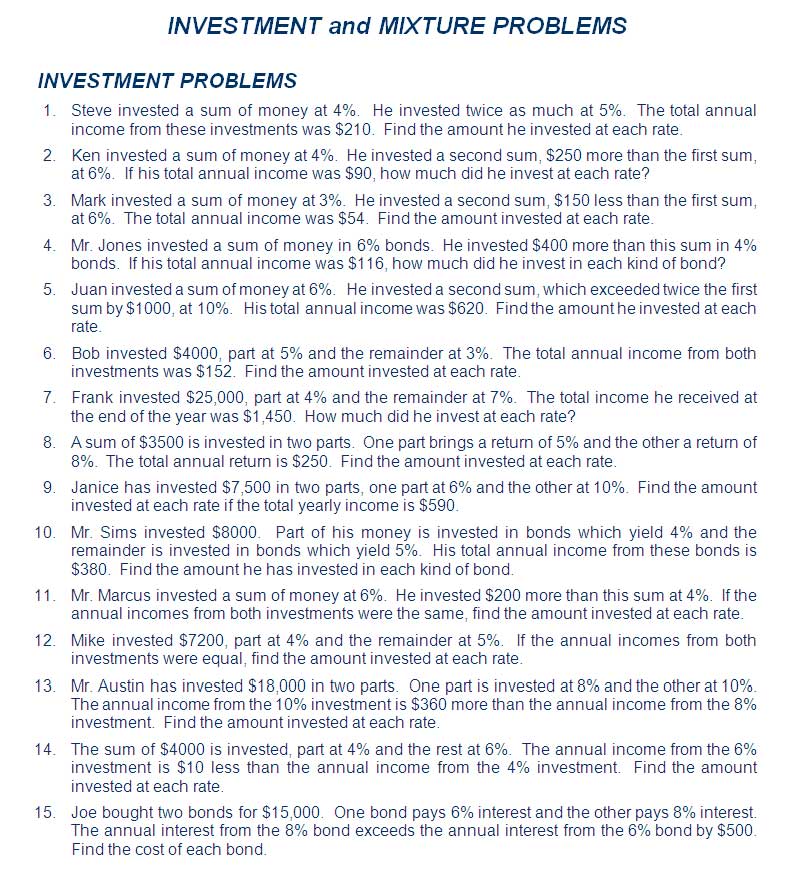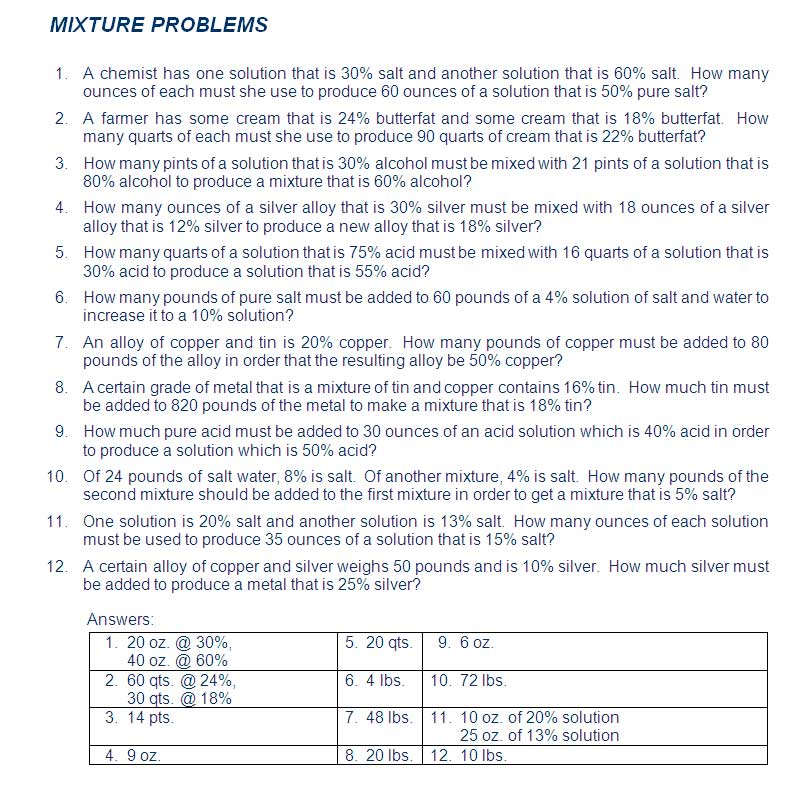INVESTMENT AND MIXTURE PROBLEMS
- - - - - - - - - - - - - - - - - - - - - - - - - - - - - - - - - - - - - - - - - - - - - - - - - - - - - - - - - - - - - - - - - - - - - - - - - |
 |
 |
Sample
Problems
INVESTMENT PROBLEMS
1. Carlos invested a sum of money at 7%. He invested a second sum, $200 more than the
first sum, at 8%. The annual income from
the two investments is $346. Find the
amount he invested at each rate.
The
formula we use is
PR = I
(Principal) X (Rate) = Interest
|
P
|
R
|
I
|
|
x
|
.07
|
.07x
|
|
x + 200
|
.08
|
.08(x + 200)
|
|
Step 1 - Write the equation
|
.07x + .08(x + 200) = 346
|
|
|
|
|
Step 2 - Multiply both sides of the equation by 100 to get rid of the decimals
|
100[.07x + .08(x + 200)] = 100(346) |
|
|
|
|
Step 3 - Use the distributive
property to multiply
8(x + 200)
|
7x + 8x + 1600 = 34600
|
|
|
|
|
Step 4 - Combine like terms
|
15x + 1600 = 34600
|
|
|
|
|
Step 5 - Subtract 1600 from both
sides
|
15x = 33000
|
|
|
|
|
Step 6 - Divide both sides of the equation by 15 to get the solution for x
|
x = 2200
|
Therefore the solution
to the problem is:
$2,200
was invested at 7% and ($2,200 +
$200) = $2,400 was invested at 8%
2. Danny
invested $11,000. Part of his money is
invested in bonds which yield 8% and the remainder is invested in bonds which
yield 10%. His total annual income from
these bonds is $1,020. Find the amount
he has invested in each kind of bond.
|
P
|
R
|
I
|
|
x
|
.08
|
.08x
|
|
11000
‑ x
|
.10
|
.10(11000
‑ x)
|
|
Step 1 - Write the equation
|
.08x + .10(11000 ‑ x) = 1020
|
|
|
|
|
Step 2 - Multiply both sides of the equation by 100 to get rid of the decimals
|
100[.08x + .10(11000 ‑ x)] = 100(1020) |
|
|
|
|
Step 3 - Use the distributive
property to multiply
10(11000
‑ x)
|
8x +110000 ‑ 10x = 102000
|
|
|
|
|
Step 4 - Combine like terms
|
-2x + 110000 = 102000
|
|
|
|
|
Step 5 - Subtract 110000 from
both sides
|
-2x = -8000
|
|
|
|
|
Step 6 - Divide both sides of the equation by -2 to get the solution for x
|
x = 4000
|
Therefore the solution
to the problem is:
$4,000
was invested at 8% and ($11000 ‑
$4000) = $7,000 was invested at 10%
MIXTURE PROBLEMS
3. A chemist has one solution that is 14% salt
and another solution which is 18% salt. How many ounces of each must be used to produce 60 ounces that is 15%
salt?
The
formula we use is
A X % = T
(Amount) X % = Total amount of each substance
|
A
|
% |
T
|
|
x
|
.14
|
.14x
|
|
60 ‑
x
|
.18
|
.18(60
‑ x)
|
|
60
|
.15
|
.15(60)
|
|
Step 1 - Write the equation
|
.14x + .18(60 ‑ x) = .15(60)
|
|
|
|
|
Step 2 - Multiply both sides of
the equation by 100 to get rid |
100[.14x + .18(60 ‑ x)] = 100(.15)(60) |
|
|
|
|
Step 3 - Use the distributive
property to multiply
18(60
‑ x)
|
14x + 1080 ‑ 18x = 900
|
|
|
|
|
Step 4 - Combine like terms
|
-4x + 1080 = 900
|
|
|
|
|
Step 5 - Subtract 900 from both
sides
|
-4x = -180
|
|
|
|
|
Step 6 - Divide both sides of the equation by -2 to get the |
x = 45
|
Therefore the solution
to the problem is:
45
ounces of the 14% solution and (60 ‑
45) = 15 ounces of the 18% solution
4. How many
pounds of pure salt must be added to 60 pounds of a 8%
solution of salt and water to increase it to a 20% solution?
Note: When a substance is pure we write 100% for the percentage of its content.
|
A
|
%
|
T
|
|
60
|
.08
|
.08(60)
|
|
x
|
1.00
|
1.00x
|
|
(60
+ x)
|
.20
|
.20(60
+ x)
|
|
Step 1 - Write the equation
|
.08(60)
+ 1.00x = .20(60 + x)
|
|
|
|
|
Step 2 - Multiply both sides of the equation by 100 to get rid |
100[.08(60)
+ 1.00x] = 100[(.20)(60 + x)] |
|
|
|
|
Step 3 - Use the distributive
property to multiply
20(60
+ x)
|
480
+ 100x = 1200 + 20x
|
|
|
|
|
Step 4 - Subtract 20x from both sides
|
480
+ 80x = 1200
|
|
|
|
|
Step 5 - Subtract 480 from both
sides
Note: Steps 4 and 5 can be combined into
one step
|
80x = 720
|
|
|
|
|
Step 6 - Divide both sides of the equation by 80 to get the |
x = 9
|
Therefore the solution
to the problem is that 9
pounds of pure salt must be added to 60 pounds of a 8%
solution of salt and water to increase it to a 20% solution.



| © Copyright 2016 Howard Sorkin All rights reserved |